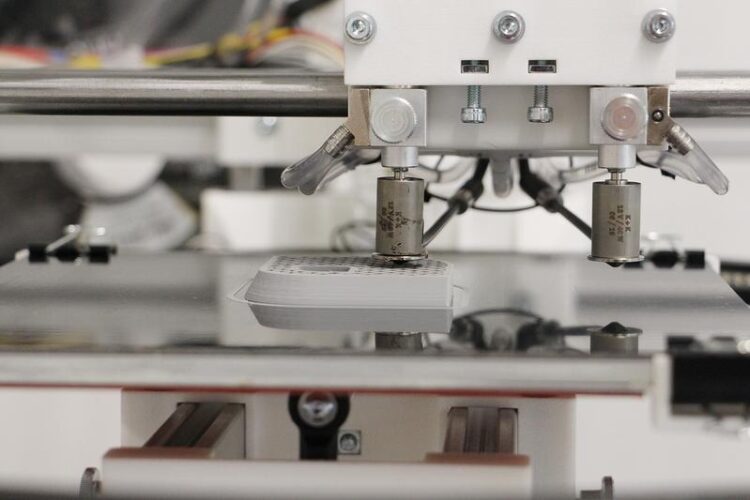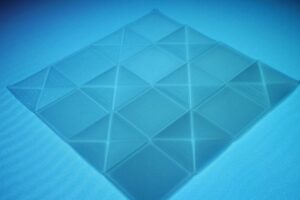Optimizing 3D-printed components for laser beam welding

Fused Deposition Modeling (FDM): In this 3D printing process, plastic components are built up layer by layer
Photo: IPH
Welding 3D-printed components with the laser: This is the goal of the scientists at the Institut für Integrierte Produktion Hannover (IPH) gGmbH and the Laser Zentrum Hanno-ver e.V. (LZH). In the new research project “QualLa”, they want to develop an expert system that supports small and medium-sized enterprises in optimizing additive manufac-turing processes – so that the printed components can subsequently be welded soundly with the laser.

Photo: LZH
For injection-molded plastic components, laser transmission welding is already an established industrial joining process. For components from the 3D printer, however, the joining does not yet work because cavities and boundary layers in the 3D-printed components prevent a uniform weld. These cavities and boundary layers are individual to each component because, in additive manufacturing, no two components are alike. Even components from the same series are only identical on the outside; the internal structure can be different.
Expert system replaces time-consuming analysis
To enable small and medium-sized enterprises (SMEs) to weld 3D-printed plastic components with lasers without analyzing each component in detail in advance, the IPH and LZH scientists want to develop an expert system and bundle process knowledge in this computer program.
In the project “Quality assurance in laser welding of additively manufactured thermoplastic components (QualLa)”, the researchers are looking at fused deposition modeling (FDM) for this purpose. In this additive process, thin strands of molten plastic are superimposed layer by layer.
Even before the 3D printing process starts, the expert system is supposed to provide recommendations on which material, which layer thickness, and which layer orientation are best suited to achieve the highest possible transmission – in other words, the highest possible permeability for the laser beam. Thanks to this preliminary work, it will be possible to weld the printed components optimally afterward.
Using AI to adapt the process to the component
In addition, the scientists want to develop a method to measure the transmission with spatial resolution. This involves determin-ing for an individual component at which points the laser beam is transmitted and to what extent. This data will then be used to control the laser transmission welding process with the help of the expert system.
If the laser beam is less transmitted at a certain point, the laser power must be increased. If the component is more light-transmissive at another point, lower laser power is sufficient. The researchers’ goal is to develop a process control system that adjusts the laser power as a function of transmission so that a uniform weld seam is produced – even if the 3D-printed compo-nent does not transmit the laser beam uniformly.
The scientists want to use machine learning methods to process the information. The plan is to use neural networks, a type of artificial intelligence that makes the expert system capable of learning. The system will learn to recognize correlations between various input variables and the print result independently and thus predict the expected transmission.
Joining plastics using laser transmission welding
Laser transmission welding can be used to join components made of thermoplastics – contact-free, automatable, without mechanical, and with low thermal stress. Two joining partners – one made of transparent, one of non-transparent plastic – are welded to each other with a laser beam. The laser beam penetrates the transparent joining partner, and as soon as it hits the non-transparent plastic, the laser light is absorbed and converted into thermal energy. As a result, the plastic in the joining area melts, and a weld seam is created.
IPH and LZH are working closely with the industry on the research project. The committee accompanying the project includes companies from the fields of laser technology, additive manufacturing and plant engineering. Other companies are wel-come to participate in the project – companies involved in artificial intelligence or additive manufacturing are particularly sought after.
Further information is available at qualla.iph-hannover.de.
Funding notice
The IGF project no. 21571N entitled “Quality assurance in laser beam welding of additively manufactured thermoplastic components (QualLa)” of the Forschungsvereinigung Forschungsgemeinschaft Qualität e.V. (FQS), August-Schanz-Straße 21A, 60433 Frankfurt am Main, Germany, was funded by the German Federal Ministry for Economic Affairs and Energy via the AiF within the framework of the program for the promotion of joint industrial research (IGF) based on a resolution of the German Bundestag.
Weitere Informationen:
https://www.iph-hannover.de/en/ Joint press release with IPH
Media Contact
All latest news from the category: Interdisciplinary Research
News and developments from the field of interdisciplinary research.
Among other topics, you can find stimulating reports and articles related to microsystems, emotions research, futures research and stratospheric research.
Newest articles

Bringing bio-inspired robots to life
Nebraska researcher Eric Markvicka gets NSF CAREER Award to pursue manufacture of novel materials for soft robotics and stretchable electronics. Engineers are increasingly eager to develop robots that mimic the…

Bella moths use poison to attract mates
Scientists are closer to finding out how. Pyrrolizidine alkaloids are as bitter and toxic as they are hard to pronounce. They’re produced by several different types of plants and are…

AI tool creates ‘synthetic’ images of cells
…for enhanced microscopy analysis. Observing individual cells through microscopes can reveal a range of important cell biological phenomena that frequently play a role in human diseases, but the process of…





















